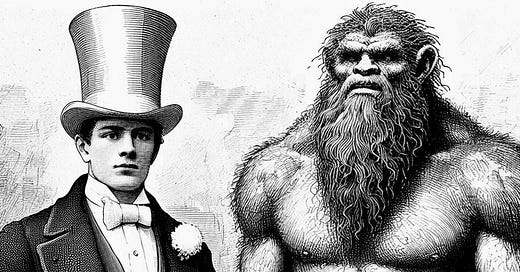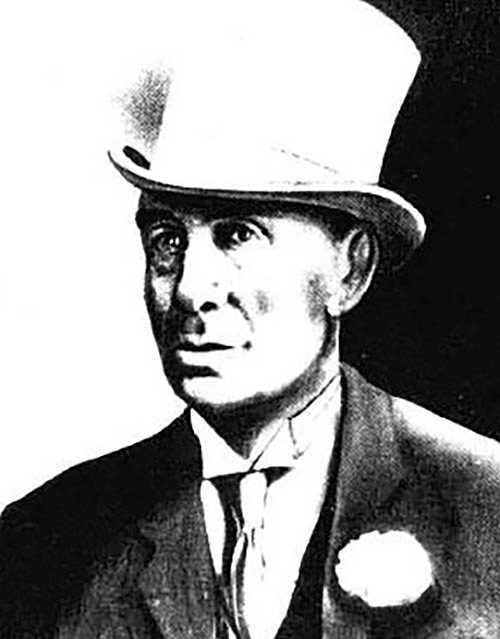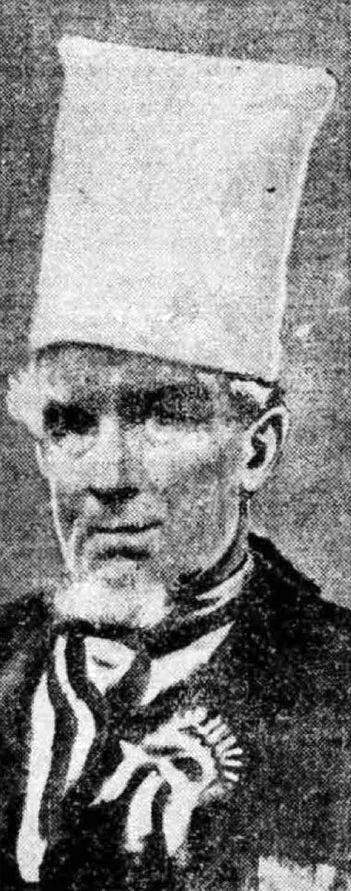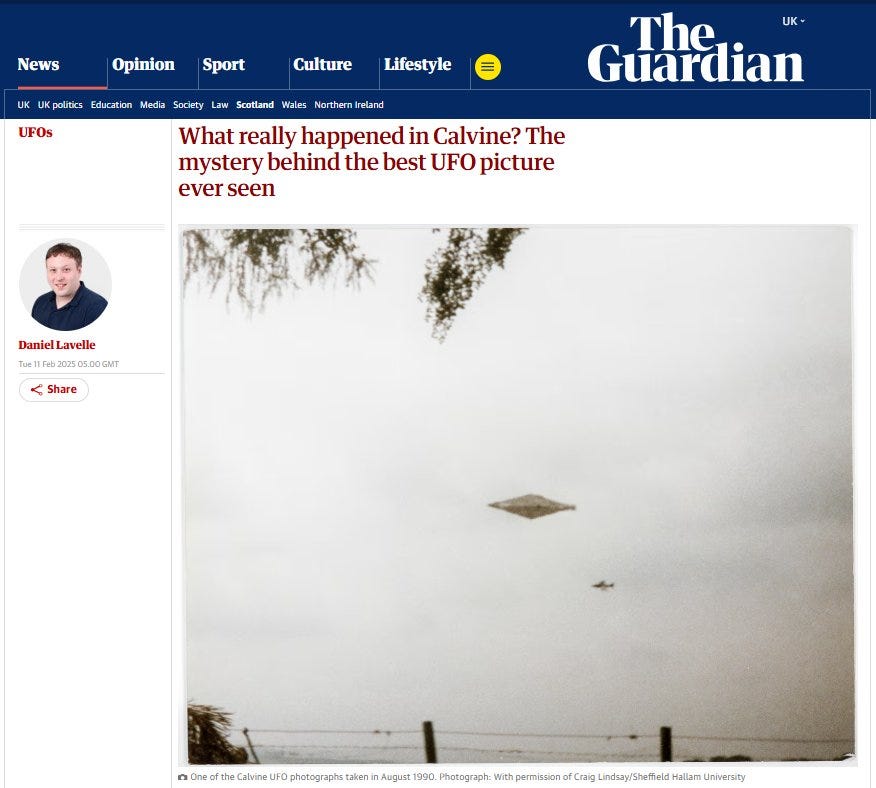Coffee Johnny and the Winlaton Wild Man
A local hero hunts for a local legend; PLUS Calvine UFO and Meta madness
In the summer of 1859, the villages of Winlaton, Blaydon, Swalwell, and Ryton, in the North East of England, were plagued by troubling appearances of a mysterious individual known as “the Winlaton Wild Man”. This fearsome character was thought to live in the woods that spilled down the hill from Winlaton into the Tyne Valley. He would come out at night into the villages, terrifying children and bothering cattle. In Winlaton — a tough industrial village that bowed to no man, wild or otherwise — a posse was formed to hunt for the Wild Man. And there was only one man to lead the posse — a celebrated “local hero” known as Coffee Johnny.
Those who had encountered him described the Wild Man as “a person of immense stature and strength” with “a beard of fabulous dimensions pendant from his chin”. He was clothed (“for he still retains a particle of decency”) in corduroy trousers and a long-sleeved white fustian vest. According to the Newcastle Chronicle, “a somewhat rakish cap is stuck upon his head, ornamented with tassels”.1
“Where he conceals himself during the day is a matter of grave uncertainty,” said the Chronicle, “but as the gloaming comes on apace, he starts up from his lair and disports himself on the bank top, up bonny Blaydon Burn” — which was the route of a stream that ran to the River Tyne from Winlaton. It was obvious why children found this “wild man on the Tyne” to be “an object of not a little solicitude”, and farmers also had reason to worry. “He is reported to have an unhappy penchant for sucking the udders of cows,” said the Chronicle, “and to prevent the supply of [milk for] the village from becoming nil, the farmers have been obliged to secure their cows at night under lock and key.”
The wild man of the woods, also known as a wodewose or woodwose, has long been a common figure in English and European folklore. Generally a large, dirty, hairy (and usually naked) man lives in the woods, the wild man is a mythical creature symbolising the antithesis of civilised society. In some tellings, he is a paranormal being who has an uncanny connection to his woodland home. In others, he is simply a human who has taken to living in the woods to escape the norms of civilisation. Winlaton and its wooded surrounds were a hotbed of myths and legends involving witches, ghosts, and vampires. It would not have surprised many locals if this latest pest was a supernatural creature akin to the legendary sasquatch or bigfoot. In any case, the udder-sucking Winlaton Wild Man was most unwelcome, and Coffee Johnny was out to catch him.
Coffee Johnny was a local hero who was soon to become a local legend. He was a six-foot-six blacksmith and bare-knuckle boxer whose real name was John Oliver. Anecdotal evidence suggests he was nicknamed “Coffee” as a child because he liked to have a cup before he went to school.2 Born in 1829, he was about 30 and recently married when he went hunting for the Wild Man.3
Like the Wild Man, Coffee Johnny was a big man with “exceptional strength”. He had a deadly reputation with his “raw ‘uns” and was said to be “an awkward customer to handle” in the ring, with hands “like a leg of mutton”. The illegal bare-knuckle matches — brutal affairs that lasted until the loser was beaten senseless (or worse) — were staged at Hedley Fell on the border between Durham and Northumberland, allowing the fighters to flee into the neighbouring county if the authorities intervened.
In 1850, aged 22, Coffee Johnny fought Will Renwick, another Winlatoner and a famed prizefighter who was twice Johnny’s age. The fight lasted 35 rounds and well over an hour, after which the battered Renwick had to be carried home in a cart with three broken ribs. This victory sealed Johnny’s reputation as a tough guy, although he was also said to be a kindly man with a great wit. Friends said he never sought a fight — although when confronted, he never turned one down.
Johnny was a popular figure. Wearing what became a trademark white top hat, he led the Winlaton Brass Band as it marched to local events such as the Winlaton Hoppings funfair, and the Blaydon Races — the horse race that secured Johnny’s fame. Geordie Ridley’s folk song The Blaydon Races contains the line, “Coffy [sic] Johnny had a white hat on – they war shootin’, ‘whe stole the cuddy.’’” This apparently relates to a story from 1861, when one of the racehorses was stolen on its way to be shod, and Johnny was the chief suspect. (Hence, “They were shouting, ‘who stole the cuddy’” — meaning a stupid horse…)4
Back in 1859, Johnny and his two dogs led Winlaton’s numerous hunters and poachers on regular searches for the “veritable wild man in the woods”. “Astounding are the exploits of Coffee Johnny, who, with a dog under each arm, and followed by a posse comitatus of lads, regularly betakes himself to the woods at night,” said the Chronicle. “Nimrods from all parts are gathering in the vicinity, and the woods are full of the noise of the chase.”
However, the paper reported, Johnny and his nimrods failed to find their prey. “Somehow, however, from some unexplained cause, they always allow the quarry to slip through their fingers at some critical period, and the wild man is still at large. In the meantime, persons with corduroy trousers and white fustian vests had better be cautious in passing the place after eight p.m., or they may have a hue and cry at their heels.”
The trail of the Winlaton Wild Man went cold, and his appearances faded away. Perhaps he had been chased from the area by Coffee Johnny’s posse. Or perhaps he was some supernatural being who mortal men could not track…
Then, five years later, the Chronicle reported the capture of a wild man at Greta Bridge, about 30 miles south of Winlaton. He was thought to be around 35 years old, with long matted hair and beard, and his feet and legs were covered with mud. He wore “a fragment of an old dressing gown, reaching from his waist to his knees, fastened around him with a cord, with a few rags clinging to his shoulders.” Was this the same wild man who had terrorised the cows of Winlaton?
Police said “his roaming had extended for a great number of miles”, and he had left a trail of terrified women, children and farmers, one of whom had been so frightened he had barricaded his farmhouse doors and windows. However, when captured, there was said to be “nothing ferocious” about him. When questioned by police, he refused to reply. At the police court, he said nothing but “God bless you” and “God preserve you.” “There is no doubt that the wild man is a harmless lunatic who has escaped from confinement,” said the Chronicle. The wild man was remanded in jail for 14 days.
Coffee Johnny died in 1900, aged 72. He was buried in a seven-foot plot at Winlaton’s St Paul’s Church, where his gravestone still stands. In his way, Johnny was himself a Winlaton Wild Man. The song, The Blaydon Races, written in 1862, has become a Tyneside anthem, closely associated with Newcastle United FC, making Coffee Johnny immortal. “Aw went to Blaydon Races, ‘twas on the ninth of June…” ◆
This is the latest in a series of posts about the weird world of Winlaton — a historic and strange village in the North East of England. (It’s pronounced “Win-lay-ton”.) You can find previous posts in this series here.
If you’re not already a subscriber, sign up for free to receive new posts every month. And if you think you know someone who might like to read Singular Discoveries, please share this with them and encourage them to join us!
Recommended
Article: What Really Happened in Calvine? by Daniel Lavelle (The Guardian)
In August 1990, two chefs from a hotel in Pitlochry in the Scottish Highlands sent six photos of what appeared to be an unidentified diamond-shaped flying object to the Daily Record newspaper. The pair claimed to have taken the photos while hiking at the nearby hamlet of Calvine. The photos showed the apparently silent and static object floating above the landscape. On its own, the object could have been anything — a balloon, an optical illusion, a hoax. But the photos also showed a military jet, identified as an RAF Harrier, apparently buzzing the object as if scrambled to intercept. According to the chefs, as the jet approached, the object shot up into the sky and disappeared.
The Daily Record did receive the photos and began an investigation by contacting the Ministry of Defence (MoD). But the Calvine incident story was never published and the photos disappeared. So, too, did the chefs, who never spoke publicly and left their jobs after some unidentified officials visited the hotel. One former MoD staffer claimed that the MoD had blocked the publication of the photos but wouldn’t speculate on the whereabouts of the two chefs. Another former MoD man said the object had been identified as a top-secret experimental aircraft belonging to the United States (speculated to be codenamed Aurora).
In 2022, the investigative journalist Dr David Clarke published one of the photos, obtained from a former MoD press officer. Clarke wrote about the Calvine incident in the excellent Fortean Times magazine. This Guardian article by Daniel Lavelle gives a very good account of “the best UFO photo ever seen”. It’s an interesting story as it stands, and particularly interesting to me as it’s reminiscent of something I saw at around the same time — 1990 — above the village this newsletter is currently exploring — Winlaton. (And close to the roaming grounds of the Winlaton Wild Man.) Here’s the story:
I was standing in my parents’ back garden, waiting for a lift from a friend. It was early evening and just getting dark. I was looking out across the Derwent Valley towards a patchwork of fields near Whickham, about two miles away. Weirdly, although there were no road or building lights in that part of the valley, one of the fields was fully illuminated. Looking closer, I noticed there was an object hovering above the field, flooding it with light. The object was too far away to see properly, but I assumed it must be a helicopter, although there was no sound.
My friend, Dave, arrived, and I pointed him to the object. As we both stood looking at it, two military jets shot over the house behind us and over our heads directly towards the object. Within a second or two, as the jets approached, the light blinked out, and the object disappeared. The jets flew over the top of the valley and out of sight. What was the object? I’ve no idea, but perhaps, like at Calvine, it was a secret experimental aircraft. Or perhaps it was aliens searching for the Winlaton Wild Man… You can read What Really Happened at Calvine? in the Guardian (free). Or find David Clarke’s article in issue 423 of Fortean Times (back issue download costs £4.99).◆
Notebook update: Last month, I wrote about the alarming big tech takeover and mentioned ways of preventing these companies from harvesting your private information. Here’s a useful guide from nonprofit organisation the Electronic Frontier Foundation (EFF) explaining how to deal with Meta (owner of Facebook, Instagram, Threads, and WhatsApp): Mad at Meta? Don't Let Them Collect and Monetize Your Personal Data by Lena Cohen.
Build your own jetpack: I’ve been delving back into my book The Rocketbelt Caper ahead of the documentary film that’s currently being made, and I found this. Just call 1-900-835-UFLY:
Thanks for reading. More next month. Please subscribe and share!
The Newcastle Daily Chronicle was founded and edited by a Winlaton man, Joseph Cowen Jnr.
Another theory suggests Coffee Johnny’s nickname was a racial slur relating to a mixed-race heritage.
Coffee Johnny and his wife Elizabeth went on to have ten children. Elizabeth died due to complications following childbirth in 1875. The tenth child, William, also died. See Genuki: The Life and Times of Coffee Johnny.
Coffee Johnny features in another Geordie Ridley song, The Blaydon Keelman, which references him as lead protector of the district alongside the Blaydon Rifle Corps and William Armstrong’s Tyneside munitions factory in the line “An’ wor heed commander Coffee Johnny, on the Tyne.”










Another great historical story Paul.